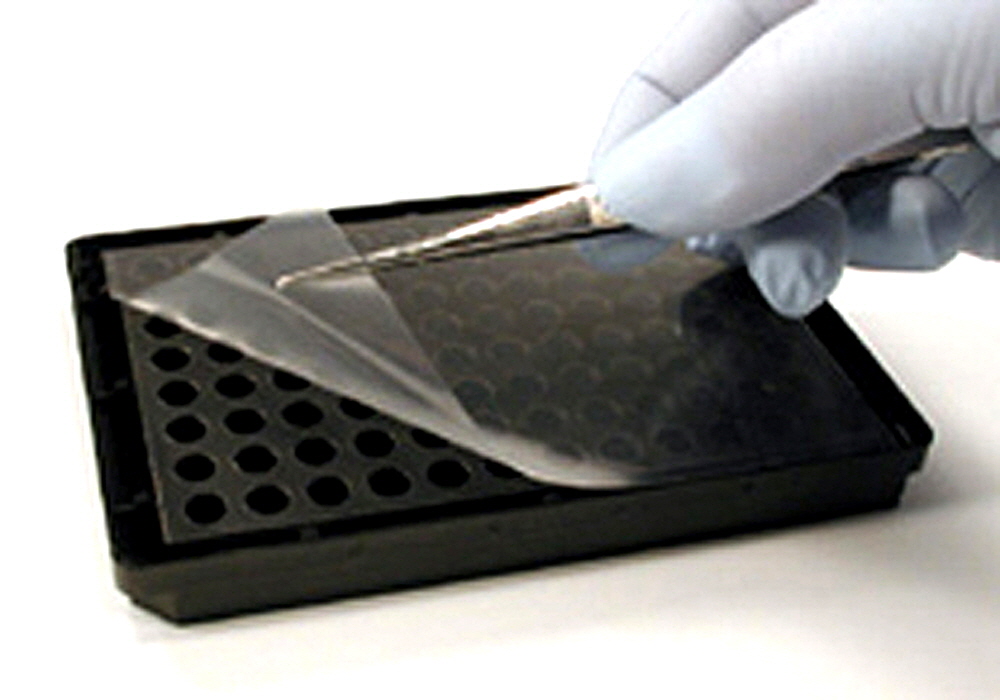ProPlate Adhesive Glass Microplates
Data Sheet
![]() Shop this product in our online store
Shop this product in our online store
Products - Microarray Substrates & Slides - ProPlate Adhesive Glass Microplates

Arrayit offers ProPlate Microarray technology for users wishing to print microarrays on glass plates and subsequently attach the printed plates to adhesive microplates for 96-well and 384-well sample processing. The ProPlate configuration offers increased printing speed and flexibility compared to pre-configured glass bottom microplates.

Figure 1. A protective coating is removed from the adhesive microplate prior to attachment to the glass plate. The adhesive provides a water-tight seal between microplate wells.

Figure 2. Arrayit LM60 Enterprise Level Microarrayers can be configured to print on glass plates for subsequent use with ProPlate Technology. The configuration shown here loads samples from one 384-well microplate and prints onto 17 destination plates (75 x 110 mm).

Figure 3. Arrayit ProPlate Glass (75 x 110 x 1 mm) is available in four surface chemistries. SuperClean has reactive hydroxyl groups allowing users to add their own chemistry. SuperAmine, SuperAldehdye 2 and SuperEpoxy 2 surfaces contain reactive amine, aldehyde and epoxide groups, respectively, for a wide variety of DNA and protein microarray applications.
ProPlate Plate Microarray Surface Chemistry
All our surface chemistries set the standard for all microarray applications. Follow these links for more information on performance, protocols and applications. See bottom of this page for pricing.
- SuperClean substrates are untreated and are delivered ready to use for custom surface chemistry preparation applications. This superior glass is cut to precision dimensions and polished to atomic smoothness to provide the most homogenous surface available in the industry. SuperClean Microarray Substrates have an average smoothness of 2.0 nm or 20 angstroms, which corresponds to approximately 10 silicon dioxide bonds.
- SuperAmine chemistry is used to immobilized unmodified long oligos and cDNAs for gene expression microarrays.
- SuperAldehyde is used to immobilized amino modified oligos, amino modified cDNA, proteins, cells, lysates, tissues, etc. This surface is specifically useful in immobilizing short oligos for SNP detection microarrays. SuperAldehyde has been used in many protein microarray applications.
- SuperEpoxy chemistry is great for protein microarrays. It is also an excellent surface to immobilize cells, tissues, and carbohydrates.
- Custom chemistries available, please call for a quote.
Legal Note
ProPlate technology is covered by United States Patent 7,063,979 issued to Grace BioLabs. ProPlate is a trademark of Grace BioLabs.
Technical Assistance
Please contact us if you have any comments, suggestions, or if you need technical assistance. By electronic mail: arrayit@arrayit.com (under the subject heading please type "ArrayIt® technical assistance"). By telephone: (408) 744-1331, Monday–Friday PST 9:00am - 4:30pm. Please remember that we want to hear about your successes!
Scientific Publications
Click here and here for recent scientific publications using ArrayIt® brand microarray products from Arrayit International, Inc for ProPlate microarray experimentation.
Recommended Equipment and Reagents
NanoPrint™ Microarrayers
SpotBot® 2 Personal Microarrayers

